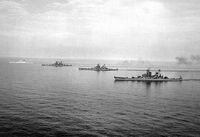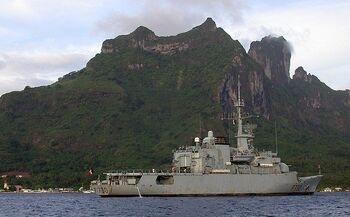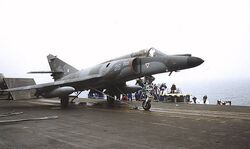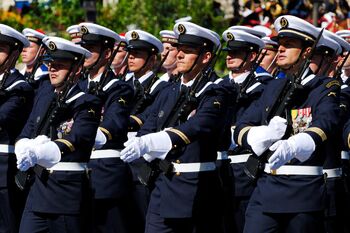
NNK Valeur under tow.
The Navy is considered the most well trained and equipped in the Armed forces therefore its personnel considers themselves elite with tremendously high morale and esprit de corps.
History[]
- ran areas during the Interregnum
- Mainland
- Enclave de Pesançon (military dictatorship loyal to King - ran by navy)
- Paroisse Côtes-d'Armor, modern-Nasbourg (loyal enclave, agreement between Catholic Movement & navy)
- Isle
- Union fidèle de Deims et Belfort de La Tondelle (Loyal Union of Deims & Belfort of La Tondelle - loyal, Deims liberal & navy base; Belfort liberal)
- Enclave of Atyr (military dictatorship, run by navy)
[]
The Force d'Action Navale (FAN) or surface fleet comprises the main force of the Marine Royale. It operates roughly 300 vessels of various sizes and functions; each designated as NNK or Navire Naval de Kanjorienne. The fleet flagship is the battleship NNK Gloire. It sails alongside two other battleships; the NNK Victoire, and NNK Honneur. These vessels are older than most of the fleet but are kept updated and operational due to their symbolic natures.
By far, the most powerful forces of the Royal Navy are the two Empereur Alphonse IV-class nuclear-powered aircraft carriers. The fleet consists of the NNK Empereur Alphonse IV and her sister ship the NNK Valeur. Both of these carriers carry upwards of forty aircraft and at least one of the vessels is on constant patrol in or around the Silliers Channel and the Isle of la Tondelle.
However, the bulk of the fleet is made up of nearly twenty-five Kanjo and Atyr-class frigates. These general purpose vessels perform numerous tasks ranging from search and rescue support to protecting vital shipping and communication routes to the Isle of la Tondelle.
The three submarine flotillas make up the largest contingent of the Navy's strategic offensive fleet. Each flotilla contains six boats of various classes and are in constant patrol in and around vital interests of Kanjor.
NOTE: As well as a number of other vessels including amphibious assault carriers, a hospital ship, and an oceanographic division.
Empereur Alphonse IV-class[]
- two Empereur Alphonse IV-class nuclear-powered aircraft carriers
Gloire class[]
The Gloire class comprises the three battleships; NNK Gloire, NNK Victoire, and the NNK Honneur.

All four of the Goire-class battleships on maneuvers. The NNK Liberté (background-far left) was decomishioned after suffering severe structural damage after a mid-voyage accident.
Cruisers[]
Charles François Gabaret class[]
- five large cruisers
- named after a région of Kanjor
- NNK Martois
- NNK Numineux
- NNK La Tondelle
- NNK Oléri-des-Grâces
- NNK Silliers
Frigates[]
The frigates make up the most important part of the surface fleet of the CDM, used for patrolling and defending Kanjor's large coastline, in conjunction with the much smaller patrol class. There are currently 12 frigates in service, with no current plans to change this figure. Several have recently operated overseas as part of Kanjor's peacekeeping missions.
Kanjo Class[]

The NNK St Claire of the coast of Tondola
The Kanjo Class frigates are older than the Atyr Class, but are still the primary surface ship of the CDM. There are 8 of the highly versatile ships, which are small; extremely stable to allow use of a heavy helicopter in all weather; with a small crew, while retaining capacities to accommodate navy commandos; light armament; economic and carrying a long-range propulsion system.
The most visible piece of armament is the standard 100 mm multipurpose gun turret, but the Kanjo class ships also carry a complete range of detection and counter-measure electronics. Each ship also carries one Oie helicopter.
The vessels in service are:
- NNK Kanjo
- NNK St Claire
- NNK Afar
- NNK Helion
- NNK Demittion
- NNK Port Erak
- NNK Belfort
- NNK Aginmont
Atyr Class[]

NNK Henri Munodi off the coast of Afar.
The Atyr Class are a extremely high tech new craft, with a stealthly design. They are not currently meant to replace the Kanjo Class frigates, but to augment the Kanjo Class's abilities for more sensitive or dangerous missions. They have a composite material of wood and glass fiber as hard as steel, light, and resistant to fire, which significantly reduces their radar cross-section. This is further aided by their very clean design.
They carry a similar variety of weapons to the Kanjo Class, though much of the information is classified. They can also carry one Oie helicopter, though this reduces their stealth effectiveness.
There are four Atyr Class frigates in service:
- NNK Atyr
- NNK Henri Munodi
- NNK Cassius
- NNK Chencka
Patrol Craft[]
The light inshore-patrol craft serve a primarily policing role, protecting the close shores of Kanjor. Only one class exists, with 6 ships.
Dauphin Class[]

NNK Dauphin, at sea
The Dauphin Class are use for customs duties, close patrolling, and police work with the GN or SSK. They are fast, and lightly armed with a 40mm cannon and two machine-guns. The ships carry an ordinary crew of 15 men, can ferry 20 people, and up to 60 for short travel with a calm sea.
They also have a crane, which can hold an anti-pollution berm, or lift small craft out of the water. With an ordinary crew, they can stay at sea for up to 15 days.
They are exceptionally stable in poor weather for their size. So far, none of the Dauphin Class ships have left Kanjoran waters.
The craft in service are:
- NNK Dauphin
- NNK Marlin
- NNK Vivaneau
- NNK Barracuda
- NNK Requin
- NNK Baleine
Other Craft[]
There are a variety of other ships use by the CMK, for many different purposes.
Pingouin Class[]
The Pingouin Class comprises four ships, three of which are dual helicopter carriers/amphibious assault craft, and one which is a hospital ship.
The assault craft can carry 16 Oie or Faucon helicopters, and hold up to 70 AFVs, including 10 Chenka MBTs, as well as up to 450 soldiers.
The craft are:
- NNK Audacieuse
- NNK Glorieuse
- NNK Moqueuse
The hospital ship NNK Gracieuse is a converted Pingouin class with a 200-bed military hospital, capable of carrying up to 100 medical and support staff. It also features a shock room, two surgery rooms, a room for treatment of burn injuries, a telesurgery room, and radiology equipment including a CAT scanner.
[]
The SAN operates carrier borne aircraft, helicopters (carried by many Kanjoran warships) and long range maritme surveillance and search and rescue aircraft. The primary carrier-borne aircraft is the 'Boucanier' produced by the Arsenal de Helion (AdH), however, it is being phased out by the AdH 'Pygargue'.
Aircraft[]
Boucanier (Buccaneer)[]

Météore II (Boucanier) over Silliers
The AdH Boucanier, a conversion of the AdH Météore II, is still the primary aircraft of the SAN. It is still popular with pilots for its ease of flight and safe airframe. It is also very damage-resistant and sturdy, but its ageing airframe and avionics have rendered it outdated for modern combat role. It has a longer range than the Météore, and has a slightly shorter take-off and landing need, which suits it for carrier use.
Pygargue (Sea Eagle)[]

Pygargue on the deck of the NNK Honneur.
The AdH Pygargue is the continuation of the Météore line, essentially a Météore III. It was not originally intended for naval use, but when the Armée de l'Air chose the Chimère V as its replacement strike craft, AdH set about converting and marketing the Météore III design as the new naval craft. The Pygargue is slightly longer than the original Météore II, and but overall is a thinner design, with a new wingframe and greater ordinance capacity. It also has modern avionics, something the Météore II was beginning to lack. Overall, the Pygargue retains the Météore II's damage-resistant and flyable aspects, into a more modern frame. Pilots thus far have been very pleased with their new planes.
Oie (Goose)[]

An Oie multipurpose helicopter
The SAN also operates many KAS Oie helicopters, the same as used by the Armée de L'Air. The Oie performs all light transportation needs for the Navy, and is well respected for its versatility and reliability in tough conditions. It has performed many at-sea rescues in extremely difficult weather, a tribute both to its stability and the skill of the pilots.
It is a twin-engined, medium-weight, multipurpose craft, that can be fitted with a variety of weapons, including pod-mounted 20 mm cannons, 68 mm rocket-launchers and side-mounted machine-guns.
Troupes de Marine[]
There is a special place in the Marine Royale, and the hearts of the people of the Isle of la Tondelle for the Troupes de marine. Composing the land arm of the Navy, and having consistently existed for nearly five hundred years, the soldiers of the troupes de marine are more likely than any other branch to be posted and serve in overseas or foreign locals. Because of their illustrious history and frequent overseas ventures, the troupes de marine consider themselves the "élite de l'élite" of the entire Armed Forces of the Crown. The training period for marines is longer than the land forces of the Army.
This high morale has led to the establishment of an unwritten yet staunch rule of leaving nobody, dead or alive, behind. Perhaps the most famous example took place during a raid on shore installation on the small, but ironically named, island of Pax during the short lived Kanjorien civil war. The body of a dead Matelot (Sailor) was left in front of a Republican strongpoint and the marines officer in charge refused to obey higher orders to reembark and instead called for volunteers to retrieve the body; the entire marines command volunteered and charged the Republican strongpoint three times in the process losing 13 more men killed. The marines even went as far as to call a naval artillery strike on the position while three volunteers crawled through the falling shells and retrieved the body for which they were given the Légion d'honneur; Kanjor's highest military award.

Troupes de marine on parade. One can see how they gained the nickname Le Bleus due to their distinctive blue uniforms.
There are four marine divisions consisting of approximately 15,000 men each. These divisions have the expressed honor of patrolling and protecting the capital, the government, and the régions of the Isle of la Tondelle. As a point of honor, other branches are generally (unless in time of war) not allowed to house combat soldiers on the Isle.
The marines are the only force trained in amphibious assault, large-scale overseas peacekeeping missions and security at naval installations. It has the unique capability of rapid deployment of major combat forces to almost anywhere on Terra within days, if not hours.
Sub-Branches[]
The Troupes de marine are divided into three sub-branches:
- Fusiliers Marins - regular infantry forces.
- Artillerie de marine - supporting forces, originally artillery but now including helicopter air support.
- Commando marine - special units, originally reconaissance but now including special forces.
All of these sub-branches are organized around the infantryman. The Troupes de marine are primarily an infantry force and every aspect of it expected to support this effort; there is no other primary mission for any marines than to support his fellows in the infantry regardless of his task. Throughout the history of Kanjor, this dedication to the art of infantry combat has proven fruitful in various battles and conflicts when marines have faced overwhelming odds only to triumph by using cooks, pilots, and artillerymen as infantry.
Ranking[]
In carrying on the tradition of the Marine Royale, the Troupes de marine use the ranking sysem of the Navy; but often the term fusilier (rifleman) is added to differentiate from ranks of the Royal Navy proper. However, the highest rank a marine may reach is Contre-amiral (Commodore). The Contre-amiral des Troupes de marine oversees the entire marine ground force and commands them in combat. Since the marines are not a separate branch, the Commodore takes orders from the naval admirality.
Ranks of the Troupes de marine:
Commander
- Contre-amiral des Troupes de marine - Commodore of the Marines
Senior Officers
- Capitaine de marine - Captain of Marines
- Capitaine de fusiliers - Captain of Riflemen (Infantry)
Junior Officers
- Aspirant - Midshipman
- Enseigne de marine deuxième classe- Ensign of Marines, Second Class
- Enseigne de marine de première classe - Ensign of Marines, First Class
- Enseigne de fusiliers - Ensign of Riflemen (Infantry)
- Lieutenant de marine - Lieutenant of Marines
Petty Officers
- Maître-principal - Principal Master
- Premier-maître - First Master
- Maître - Master
- Second-maître - Second Master
- Major - Major
Sailors
- Matelot de fusiliers - Sailor of Riflemen (Riflemen Sailor, or simply Riflemen)
- Matelot - Sailor
A unique feature of the marines is the reliance on junior officers for its combat effectivness and flexibility. The vast majority of marines are enlisted men, falling between the Matelot and Maître-principal ranks. Most platoons are headed by relatively low ranking "officers", especially in comparison to the other branches of the military of Kanjor. This emphasis on Petty Officers has created a culture of advancement from within; almost all officer ranks, above Petty Officers, began their careers as enlisted Matelots and were fast-tracked through officer training after showing promise that was realized by mide-level officers.
Experts agree that all levels of marine officers would universally hold higher ranks in the other branches of the Armed Forces of the Crown. It is because of the esprit de corps of the marines that the majority of these officers remain in the Marine Royale for their careers. Often, being a marine officer is a familial affair which is passed down through generations.
| Royal Navy Marine Royale | |
|---|---|
 Naval Ensign of the Kanjorien Navy | |
| Active | 8 May 1575 - present |
| Country | Federal Republic of Kanjor |
| Allegiance | [[]] |
| Branch | Armed Forces of Kanjor |
| Type | Navy |
| Size | 68,000 personnel & 2500 civilians 172 ships 200 aircraft |
| Motto | Honneur, gloire, victoire (Honor, glory, victory) |
| Anniversaries | Navy Day (May 8th)
Submariners Day (September 19th) |
| Commanders | |
| Current commander |
Generaladmiral (May, 4359) |
